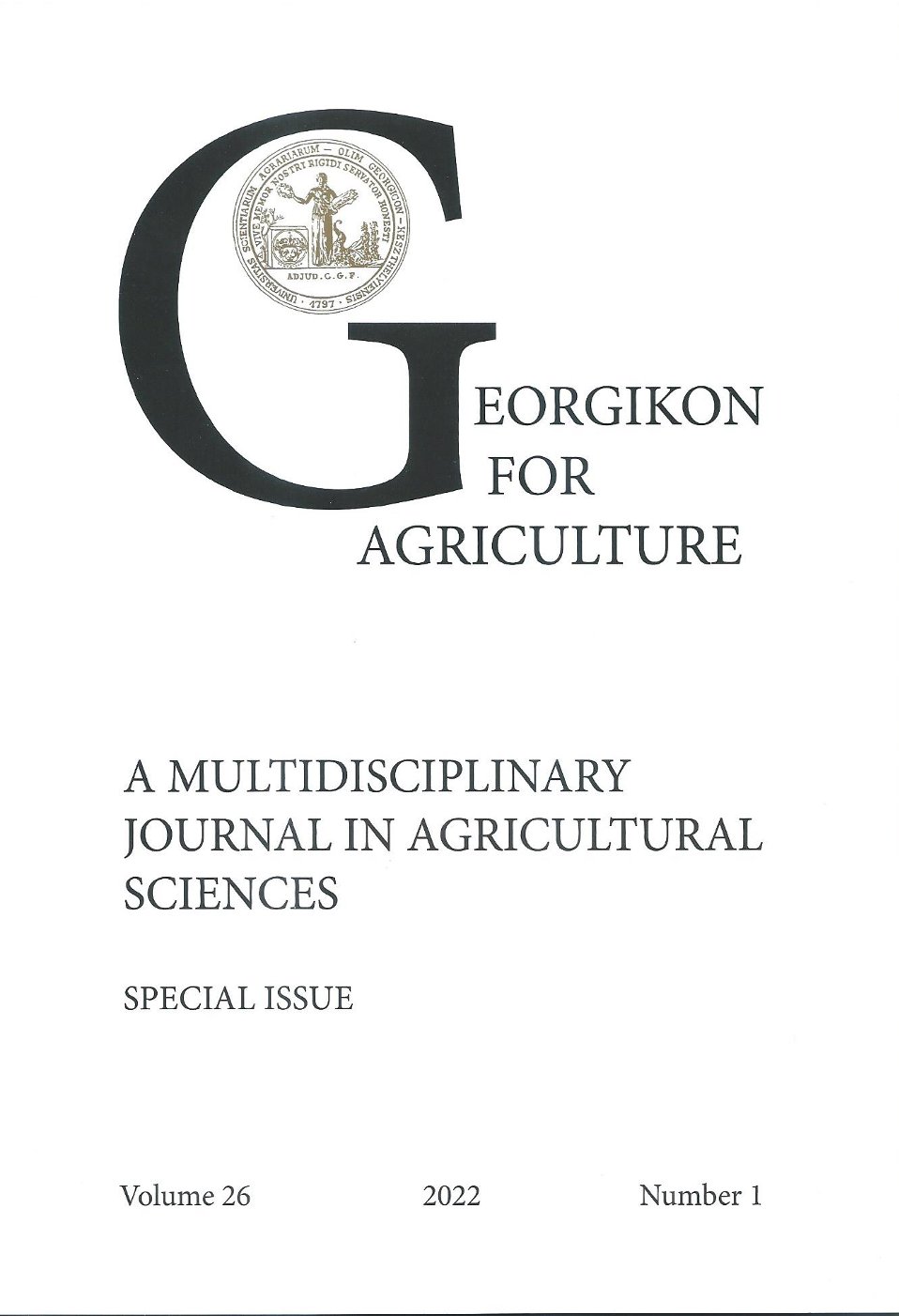A leanderrák kórokozójának, a Pseudomonas savastanoi pv. nerii baktériumfaj izolátumainak azonosítása és összehasonlítása hazánkban
Kulcsszavak:
Nerium oleander, Pseudomas savastanoi pv nerii, leanderrákAbsztrakt
Hazánkban már régóta népszerű és mutatós dézsás növény a leander. Bárhol, ahol feltűnik, mediterrán hangulatot teremt. Legsúlyosabb betegsége a leanderrák vagy másnéven a leander pszeudomonászos betegsége, amit a Pseudomonas savastanoi pv. nerii baktérium okoz. A betegség tipikus tünetei a rákos daganatok, melyek a növény összes földfeletti részén képződhetnek. A dísznövények esztétikai értékének csökkenése mellett idővel a növény kondíciója leromlik, és el is pusztulhat. Vizsgálatunkban az ország különböző pontjairól gyűjtött leander növényekből izoláltuk a Pseudomonas savastanoi pv. nerii kórokozót. Azonosítását, jellemzését, valamint az izolátumok összehasonlítását klasszikus módszerekkel - hiperszenzitív reakció, Gram tulajdonság, biokémiai jellemzők, patogenitási teszt, LOPAT teszt- végeztük el.
Hivatkozások
Bozkurt, I.A., Soylu, S., Mirik, M., Ulubas Serce C. and Baysal Ö. 2014. Characterization of bacterial knot disease caused by Pseudomonas savastanoi pv. savastanoi on pomegranate (Punica granatum L.) trees: a new host of the pathogen. Letters in Applied Microbiology. 59. 520–527.
Bradbury, J.F. 1986. Guide to Plant Pathogenic Bacteria. Wallingford, UK: CAB International.
Cinelli, T., Marchi, G., Cimmino, A., Marongiu, R., Evidente, A. and Fiori, M. 2014. Heterogeneity of Pseudomonas savastanoi populations infecting Myrtus communis in Sardinia (Italy). Plant Pathology. 63(2). 277–289.
Eltlbany, N., Prokscha, Z.Z., Castañeda‐Ojeda, M.P., Krogerrecklenfort, E., Heuer, H., Wohanka, W., Ramos, C. and Smalla, K. 2012. A new bacterial disease on Mandevilla sanderi, caused by Pseudomonas savastanoi: lessons learned for bacterial diversity studies. Applied and Environmental Microbiology. 78. 8492-8497.
Ferraris, T. 1926. Trattato di patologip e terapia vegetale, vol. 1, 3rd ed. Hopli, Milan.
Garcia De Los Rios, J.E. 1999. Retama sphaerocarpa (L.) Boiss, a new host of Pseudomonas savastanoi. Phytopathologia Mediterranea. 38. 54–60.
Gregersen, T. 1978. Rapid method for distinction of gram-negative from gram-positive bacteria. European Journal of Applied Microbiology and Biotechnology. 5(2). 123–127.
Mansfield, J., Genin, S., Magori, S., Citovsky, V., Sriariyanum, M., Ronald, P. and Foster, G.D. 2012. Top 10 plant pathogenic bacteria in molecular plant pathology. Molecular Plant Pathology. 13(6). 614–629.
Janse, J.D. 1982. Pseudomonas syringae subsp. savastanoi (ex Smith) subsp. nov., nom. rev., the bacterium causing excrescences on Oleaceae and Nerium oleander L. International Journal of Systematic and Evolutionary Microbiology. 32(2). 166–169.
Janse, J.D. 1981. The bacterial disease of ash (Fraxinus excelsior), caused by Pseudomonas syringae subsp. savastanoi pv. fraxini II. Etiology and taxonomic considerations. European Journal of Forest Pathology. 11(7). 425-438
Kavak, H. and Ustun, N. 2009. Oleander knot caused by Pseudomonas savastanoi pv. nerii in Turkey. Journal of Plant Pathology. 91(3). 701-703.
Klement, Z. 1982: Hypersensitivity, In: Phytopathogenic Prokaryotes, Vol. 2. Mount, M.S. and Lacy, G.H. eds. Academic Press, New York, 147–177.
King, E.O., Ward, M.K. and Raney, D.E. 1954. Two simple media for the demonstration of pyocyanin and fluorescin. Journal of Laboratory and Clinical Medicine. 44. 301-307.
Lelliott, R.A., Billing, E. and Hayward, A.C. 1966. A Determinative Scheme for the Fluorescent Plant Pathogenic Pseudomonads. Journal of Applied Bacteriology. 29(3). 470–489
Marchi, G., Sisto, A., Cimmino, A., Andolfi, A., Cipriani, M.G., Evidente, A. and Surico, G. 2006. Interaction between Pseudomonas savastanoi pv. savastanoi and Pantoea agglomerans in olive knots. Plant Pathology. 55(5). 614–624.
Matas, I.M., Pérez‐Martínez, I., Quesada, J.M., Rodríguez‐Herva, J.J. Penyalver, R. and Ramos, C. 2009. Pseudomonas savastanoi pv. savastanoi contains two iaaL paralogs, one of which exhibits a variable number of a trinucleotide (TAC) tandem repeat. Applied and Environmental Microbiology. 75. 1030–1035.
Surico, G. and Iacobellis, N.S. 1992. Phytohormone and olive knot disease. In: Verma, D.P.S. Molecular Signals in Plant-Microbe Communications. CRC Press, Boca Raton, USA. 209-227.
Saad, A.T. and Hanna, L. 2002. Two new hosts of Pseudomonas savastanoi and variability in strains isolated from differenthosts. Phytopathology. 92. S71.
Schaad, W., Jones, J.B. and Chun, W. 2001. Laboratory Guide for Identification of Plant Pathogenic Bacteria. 3rd Edition, American Phytopathological Society, St. Paul, 373.
Szatmári Sz., Khadija E. és Hevesi M. 1998. Daganatképző baktériumok hazai előfordulása. In IX. Lippay János-Vas Károly Nemzetközi Tudományos Ülésszak, Növényvédelmi Szekció, 1998. szeptember 16-18., Kertészeti és Élelmiszeripari Egyetem, Budapest. 340.
Surico, G., Iacobellis, N.S. and Sisto, A. 1985. Studies on the role of indole‐3‐acetic acid and cytokinins in the formation of knots on olive and oleander plants by Pseudomonas syringae pv. savastanoi. Physiological Plant Pathology. 26. 309–320.
Thornley, M.J. 1960. The differentiation of Pseudomonas from other Gram-negative bacteria on the basis of arginine metabolism. Journal of Applied Bacteriology. 23. 37–52.
Young, J.M., Saddler, G.S., Takikawa, Y., De Boer, S.H., Vauterin, L., Gardan, L., Gvozdyak, R.I. and Stead, D.E., 1996. Names of plant pathogenic bacteria 1864-1995. Review of Plant Pathology. 75. 721-763.
Letöltések
Megjelent
Folyóirat szám
Rovat
License
Copyright (c) 2022 Fodor Attila, Palkovics László, Juhász Áron, Végh Anita

This work is licensed under a Creative Commons Attribution-NonCommercial-NoDerivatives 4.0 International License.
The articel is under the Creative Commons 4.0 standard licenc: CC-BY-NC-ND-4.0. Under the following terms: You must give appropriate credit, provide a link to the license, and indicate if changes were made. You may do so in any reasonable manner, but not in any way that suggests the licensor endorses you or your use. You may not use the material for commercial purposes. If you remix, transform, or build upon the material, you may not distribute the modified material. You may not apply legal terms or technological measures that legally restrict others from doing anything the license permits.




 Georgikon for Agriculture
Georgikon for Agriculture